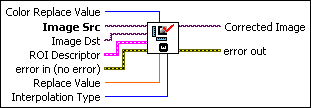IMAQ Correct Calibrated Image VI
Owning Palette: CalibrationInstalled With: NI Vision Development ModuleCorrects a calibrated image by applying a calibration to create a spatially correct image.






 |
Color Replace Value is the value used to replace pixels in a corrected color image that were not part of the original image. |
||||||||||
 |
Image Src is a reference to the source image. |
||||||||||
 |
Image Dst is a reference to the destination image. |
||||||||||
 |
ROI Descriptor is the ROI to be corrected.
|
||||||||||
 |
error in (no error) describes the error status before this VI or function runs. The default is no error. If an error occurred before this VI or function runs, the VI or function passes the error in value to error out. This VI or function runs normally only if no error occurred before this VI or function runs. If an error occurs while this VI or function runs, it runs normally and sets its own error status in error out. Use the Simple Error Handler or General Error Handler VIs to display the description of the error code. Use error in and error out to check errors and to specify execution order by wiring error out from one node to error in of the next node.
|
||||||||||
 |
Replace Value is the value that the VI uses to fill pixels in the corrected image that the VI could not correct in Image Src. The default is 0. |
||||||||||
 |
Interpolation Type specifies the interpolation method used to obtain the corrected image. The default is Zero Order. The following options are valid:
|
||||||||||
 |
Corrected Image is the reference to the corrected destination (output) image. If the Image Dst is connected, then Corrected Image is the same as Image Dst. Otherwise, Corrected Image refers to the image referenced by Image Src. |
||||||||||
 |
error out contains error information. If error in indicates that an error occurred before this VI or function ran, error out contains the same error information. Otherwise, it describes the error status that this VI or function produces. Right-click the error out indicator on the front panel and select Explain Error from the shortcut menu for more information about the error.
|
Examples
Refer to the following for an example that uses this VI.
- LabVIEW\examples\Vision\2. Functions\Calibration\Simple Calibration Example.vi








